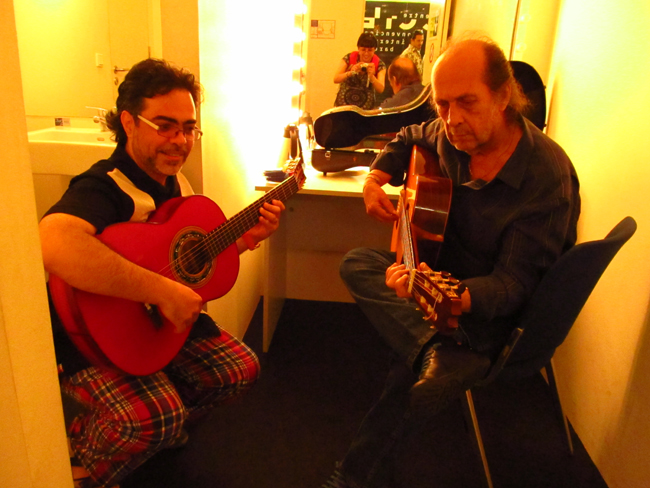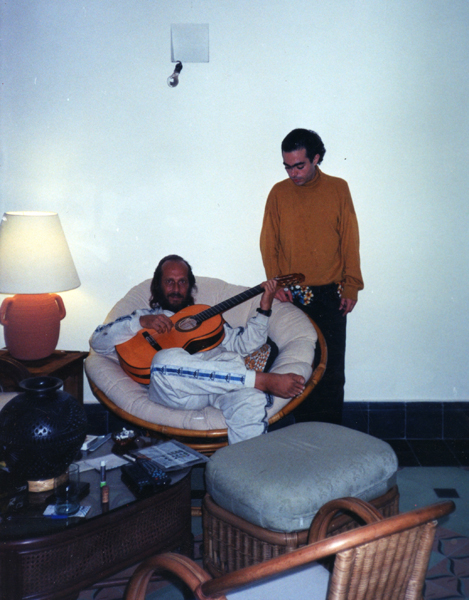
A new definition of flamenco guitar as an instrument(November 2018)
|
||||||
 |
||||||
Part 9 |
||||||
“Obsolete flamenco means flamenco without improvisation” (Paco de Lucia) |
||||||
| The original newspaper in Spanish: | ||||||
To give the context of this subject matter let’s start with the essence that Paco revealed in the following two videos; I) Paco himself saying that "Flamenco doesn’t belong anymore to the people of Andalucía": |
||||||
| II) Paco pointing out what is the new goal in flamenco guitar: | ||||||
| See also Modern vs Old style of flamenco | ||||||
| In flamenco circles people often talk about the so called "tradition" while many of them may not know at all what the very word tradition means. The whole thing is far beyond the mere question of who likes the new flamenco music and who doesn't - although, for sure, there's plenty of material to discuss about that |
||||||
| but if someone is blamed as guilty of rupture inside a tradition (Paco) | ||||||
better first take a look at what precisely a tradition is: Etymologically, the word comes from the Latin “traditio” which means a passing on, a releasing of something older to something newer, a handing over, a heritage, a continuation. Extradite, from the same root, tradition means bringing back. But “tradition” also indicates a giving up, as in a betrayal (in Spanish there is the word “traición”) Actually tradition and betrayal have the same root. The ancients had a sense as if these are children of the same mother so to say; been able to distinguish one from the other primarily through the principles we project onto each. The "authentic" flamenco was tribal in every sense of the word: very cultish, clannish, and restricted, and those are negative words in our culture, nonetheless it is the music of a secluded and isolated population. Flamenco was by gypsies, for gypsies, and about gypsies – about their own rhythms and aura, but even if old flamenco was clannish and culturally constrained it was at the same time definitely a music bursting with life and juice, back then the Andalusian flamencos themselves were typically uneducated and illiterate, and by modern standards they would have been considered to be urban primarily insofar because they lived inside of edifices rather than in tents or convoys (although some did that too) Gypsies lived and survived in any way they could: they were laborers, farmers, small tradesmen, bakers, horse-traders, fast-talkers and con-men, none went to college, got a degree, became an engineer or a physician or a professor, ran a successful business enterprise, had a successful military or legal or civil service career, became an painter or scriptwriter, a city councilman or a diplomatic or a cop or fireman or a manager...or a trained and skilled technician, or a photographer or designer or an architect, or technologist, or anyone who was trusted with money, or who was the fitting theme of a biography. From the point of view of the mainstream society, these were the throw-aways. Remember that under generalisimo Franco’s repression, the “gitanos” were prohibited from higher education, although they had to go to regular school like everyone else, but they didn’t stay there too long either. Thus living inside such lack of social services, electricity, running water, dental care and basic sanitation, not unlike from being a poor Afro-American man who lived himself the harsh history of the American South. It’s not by chance that flamenco has been called the gypsy blues. Next you have Miles Davis saying that |
||||||
and just like fine original blues, flamenco music also happened in secluded surroundings which may have included friends and neighbors, it was like a "cosa nuestra" – "our thing" – and it was problematic for non-gypsies to gain admission into these circles then. Around 1930, time of pronounced distress in Spain, some of the prominent flamenco artists formed groups themselves and traveled or started playing gigs or shows in other countries; these travelers gave the world its first taste of the regional folkloric flamenco, and by doing so they created some audience around, is important to notice that those first shows were stage performances – an entirely new phenomenon with ticket sales, a starting time, a program of set pieces, showy costumes, and in some cases shows with an eye-catching finale at the end, anyways something had been created that amused and which gave some people way to get a living which they wouldn't have had previously otherwise . Old flamenco was never something that started at 9p.m. on Thursday the twenty-first and ended ninety minutes later in a theater. https://ricerche.aquilacorde.com/chi-e-mimmo-peruffo/ have created many different synthetic materials to emulate gut strings and beyond, in 2018 Mimmo also created some fantastic strings made out of Sugar, those are really excellent strings |
||||||
| but in the past the only option for strings was gut strings, therefore in a sense we are indebted to the “flamencos” for their sudden finding and in a historical manner so to say to the Augustine strings which was the first company to popularize nylon strings for guitar through Andres Segovia’s endorsement. Now getting back to my preceptor Paco de Lucia |
||||||
 |
||||||
| his main contribution is that he iincluded the improvisation factor in flamenco | ||||||
| and of course he carried the thrust to make flamenco respectable many steps further than his predecessors, Paco made flamenco respectable by insisting that it should be included in more “formal” musical programs (i.e., that were more in line with the musical tastes of the middle class then) and that the flamenco artists should be paid at least the same as other performers. As prove of my teaching: |
||||||
| and formal exploration of Paco de Lucias’s compositional and improvisational style https://goo.gl/TVhSwm and that related to my research of his technique, here you have a link to my YouTube channel with +2,500 videos about the subject. | ||||||
| Next are some important words of Paco which people seems to forget nowadays: | ||||||
| 1) “I leave Spain because the atmosphere here is unbreathable for me… The prejudices, the flamenco orthodox people, the tradition… I don’t like any of that. I want fresh air. I need to work freely, without static purism which ties me up. The orthodox have messed with me nonstop since I started to have success…” 2) “Here (in Spain) I’m always tense, neurotically thinking if I’m doing good or wrong, or if I am bothering someone with my work, I guess I will have to beg forgiveness “to Spain” because I’m a successful person…” 3) “I really want to work full-time with jazz players. I think they have a very decisive musical movement and I’m so interested in all that. My flamenco roots will never be lost but I have so much to see and to learn regarding techniques, sounds and rhythms.” 4) “The purists want me to play the same things as always. They want me to play obsolete music without experimentation or improvisation.” In other words Paco’s own definition of obsolete flamenco is a flamenco devoid of improvisation either be it parroting falsetasor otherwise. |
||||||
| I invite you to reflect deeply on what Paco said there, in contrast with some people who may also say (just for political reasons) that Paco de Lucía do represent the “new orthodoxy”, but I believe those who say that are doing it so as a desperate attempt to justify their own mediocrity. The reality is that today, inisde the spanish flamenco guitar comunity there is absolutely zero new ideas concepts or techniques for flamenco music creation, nowadays there is nothing around which Paco had not already done himself 30 years ago. |
||||||
| At present Paco's work continues to be vanguard as none of the present flamenco players today have being able (so far) to equal the complexity, mastery, deepness and beauty of Paco's music. |
||||||
| Top | Next | |||||